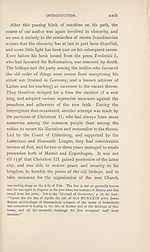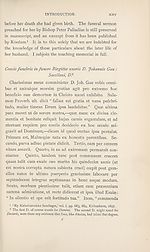Scottish Text Society publications > Old series > Richt vay to the Kingdome of Heuine
(30) Page xxiv
Download files
Complete book:
Individual page:
Thumbnail gallery: Grid view | List view

XXIV
INTRODUCTION.
During these unquiet years it is supposed that Gau remained
about Malmo, and that in 1536 he married a lady bearing
the name of Birgitta, the daughter of one of its honoured
citizens. But soon after, if not before, peace was restored
to the kingdom, and the Church was organised by John
Bugenhagen1 (whom, at the request of the king, Luther had
sent to counsel and direct in that work), our author is found
at Copenhagen, holding an appointment as one of the chap¬
lains or prebendaries of the Church of Our Lady;2 and
he continued to reside there for the rest of his days,
cheered by the affectionate care of his wife, and the friend¬
ship of his countryman Machabaeus, and the young
Scotchmen his fame drew to the University of Copenhagen,3
as well as of the many Scottish merchants in the city, and
enjoying the respect of his fellow-chaplains and former
fellow-labourers in Malmo. He is supposed to have died
in 1553. His wife predeceased him in iSSL leaving a
daughter seven years old, and the twins to whom shortly
1 As set forth in the ‘Ordinatio Ecclesise Danicse’ of 1537-
2 The Vor Frue Kirke, or Our Lady’s Church in Copenhagen, seems to have
been the principal church in the city. Before the Reformation it had a staff of
canons as well as vicars and altar priests. After the Reformation it had several
chaplains or vicars, and the endowments of several of the altarages were appro¬
priated in aid of the salaries of professors in the University, or in support of
hospitals or other charities. A certain Petrus Scotus was a vicar in it before
the Reformation, and Gau a chaplain after it. The revenues of the altarage
of St Ninian, founded by the numerous Scottish merchants in the city, were
ultimately transferred to the Hospital of the Holy Spirit. See Rordam’s ‘ Kioben-
havns Kirker,’ pp. 206, 324, 370, “ Samme aar [12th Sept. 1539] overdrog
Tilsynsmsendene ved S. Niniani Alter i Vor Frue Kirke, der var oprettet af de
mange Skotter, som paa denne Tid opholdt sig i Kjobenhavn al den Rente,
Penge, Indkomst og Opgjaeld, med Kalk, Disk og andre Klenodier, som
Alteret havde haft til Helligaand’s Hospital, mod at der skulde oprettes
tvende Senge for syge af den Skotske Nation, som skulde holdes med Klseder,
Mad, Oel og Rdgt.” The deed of transference is given at length in Hofman’s
‘ Samlinger,’ vol. x. p. 156.
3 James Melville’s father, and his pupil, young Erskine of Dun, studied under
Machabseus. Melville’s ‘Diary,’ p. 14.
INTRODUCTION.
During these unquiet years it is supposed that Gau remained
about Malmo, and that in 1536 he married a lady bearing
the name of Birgitta, the daughter of one of its honoured
citizens. But soon after, if not before, peace was restored
to the kingdom, and the Church was organised by John
Bugenhagen1 (whom, at the request of the king, Luther had
sent to counsel and direct in that work), our author is found
at Copenhagen, holding an appointment as one of the chap¬
lains or prebendaries of the Church of Our Lady;2 and
he continued to reside there for the rest of his days,
cheered by the affectionate care of his wife, and the friend¬
ship of his countryman Machabaeus, and the young
Scotchmen his fame drew to the University of Copenhagen,3
as well as of the many Scottish merchants in the city, and
enjoying the respect of his fellow-chaplains and former
fellow-labourers in Malmo. He is supposed to have died
in 1553. His wife predeceased him in iSSL leaving a
daughter seven years old, and the twins to whom shortly
1 As set forth in the ‘Ordinatio Ecclesise Danicse’ of 1537-
2 The Vor Frue Kirke, or Our Lady’s Church in Copenhagen, seems to have
been the principal church in the city. Before the Reformation it had a staff of
canons as well as vicars and altar priests. After the Reformation it had several
chaplains or vicars, and the endowments of several of the altarages were appro¬
priated in aid of the salaries of professors in the University, or in support of
hospitals or other charities. A certain Petrus Scotus was a vicar in it before
the Reformation, and Gau a chaplain after it. The revenues of the altarage
of St Ninian, founded by the numerous Scottish merchants in the city, were
ultimately transferred to the Hospital of the Holy Spirit. See Rordam’s ‘ Kioben-
havns Kirker,’ pp. 206, 324, 370, “ Samme aar [12th Sept. 1539] overdrog
Tilsynsmsendene ved S. Niniani Alter i Vor Frue Kirke, der var oprettet af de
mange Skotter, som paa denne Tid opholdt sig i Kjobenhavn al den Rente,
Penge, Indkomst og Opgjaeld, med Kalk, Disk og andre Klenodier, som
Alteret havde haft til Helligaand’s Hospital, mod at der skulde oprettes
tvende Senge for syge af den Skotske Nation, som skulde holdes med Klseder,
Mad, Oel og Rdgt.” The deed of transference is given at length in Hofman’s
‘ Samlinger,’ vol. x. p. 156.
3 James Melville’s father, and his pupil, young Erskine of Dun, studied under
Machabseus. Melville’s ‘Diary,’ p. 14.
Set display mode to: Large image | Zoom image | Transcription
Images and transcriptions on this page, including medium image downloads, may be used under the Creative Commons Attribution 4.0 International Licence unless otherwise stated. ![]()
| Publications by Scottish clubs > Scottish Text Society publications > Old series > Richt vay to the Kingdome of Heuine > (30) Page xxiv |
|---|
| Permanent URL | https://digital.nls.uk/113770220 |
|---|
| Description | A collection of over 100 Scottish texts dating from around 1400 to 1700. Most titles are in Scots, and include editions of poetry, drama, and prose by major Scottish writers such as John Barbour, William Dunbar, Gavin Douglas, and George Buchanan. Edited by a key scholarly publisher of Scotland's literary history, and published from the late 19th century onwards by the Scottish Text Society. Available here are STS series 1-3. |
|---|

